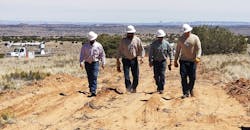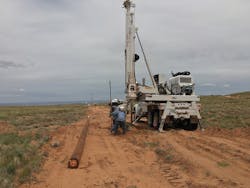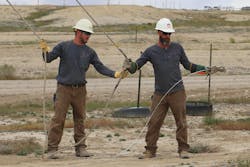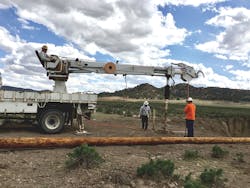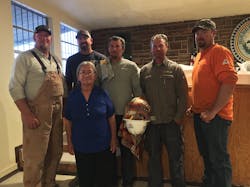Since its establishment in 1959, the Navajo Tribal Utility Authority has focused on its primary mission to provide safe, reliable and affordable utility services to the Navajo people. For the past six decades, the biggest obstacle has remained the same: The sprawling, unforgiving terrain of the 27,000-sq mile (69,930-sq km) Navajo Nation coupled with the remote, rural locations of many residents makes it nearly impossible to extend power lines or water lines to every home. Approximately 15,000 Navajo families, or about 60,000 individuals, live without electricity on a reservation the size of West Virginia. This number accounts for 70% of all households without electricity in the United States.
The Navajo Tribal Utility Authority (NTUA) was created by Navajo leaders to directly meet the utility needs of the Navajo Nation and its people. Their need for electricity was virtually ignored by the federal government and local electric utilities when the rest of the U.S. was provided electricity in the 1930s and 1940s under the Rural Electrification Act, signed by President Franklin D. Roosevelt. Unfortunately, the Navajo people were overlooked and, for many, even today this law has yet to be applied. For decades, NTUA has worked hard to extend electricity to as many Navajo homes as possible. Yet, with new families constantly moving to the Navajo Nation, it is impossible for NTUA to keep up with the demand.
To address this daunting challenge with a new approach, NTUA partnered in 2019 with the American Public Power Association (APPA) to create a unique and innovative electrification project called Light Up Navajo (LUN). The primary goal was to connect as many homes as possible within an expedited timeline. The project brought to the Navajo Nation electric linemen representing communities throughout the U.S. Over the course of six weeks, these LUN volunteers connected 233 homes, dramatically changing hundreds of Navajo families’ lives.
The Beginnings
Imagine life without electricity. Without television, computers, tablets, mobile phones and appliances as simple as toasters. Picture life where refrigerators do not exist because there is no electric power. Oil burning lamps, kerosene lanterns and flashlights are the only lights once the sun goes down. Ice chests are within reach to keep perishable food cold. “That’s what I did, used ice chests for my food,” said Lillie Wilson, a northern Arizona elder who never had electricity. “After two days, I had to throw the food out because it went bad.”
In 2019, these scenarios were a part of everyday life for thousands of families. “My four-year old loves ice cream, but he could never have it at home,” said Rethema Kenny, who moved her family to their traditional homestead so her children could grow up living in the Navajo culture. “We would buy it at the store and tell him to eat it then and there.”
These sorts of circumstances were shared with members of the APPA, a not-for-profit association representing community-owned utilities that power 2000 towns and cities across the U.S. One of the APPA taglines is “Powering Strong Communities.” Each year, the association applies this motto through its mutual-aid program, which is activated when an area gets hit with weather-related power outages like hurricanes, tornadoes, floods and ice storms. APPA members dispatch crews to these regions to help restore power as soon as they can safely. It was through APPA membership the idea of mutual aid for the Navajo people was conceived. Conversations unfolded, and the concept took root. From this, LUN became a reality.
Getting Ready
A pre-planning meeting was held in September 2018. More than 30 people, representing more than 50 utilities, traveled to the Southwest to begin the planning process. Utility representatives got to see two families turn on light switches in their homes for the first time. Most of these member communities returned to their home bases and petitioned for approval to help bring positive change to Navajo homes and become part of the LUN pilot project.
Electric line crews from Arizona, Arkansas, California, Delaware, Illinois, Indiana, Massachusetts, New Mexico, Oklahoma, Ohio, Texas and Utah traveled to the Navajo Nation for the project. Two of the visiting utilities were independently owned investor utilities that neighbor the Navajo Nation, which spans parts of Arizona, New Mexico and Utah. A total of 138 volunteers joined the LUN effort. They spent up to 12 hours a day setting power line poles, stringing wire, mounting transformers and placing electric meters. Often, it took crews an hour or longer to travel to traditional homesites where families have lived for generations. Homesteads are scattered in scenic desert locations, often framed by red sandstone formations and surrounded by stunning vistas.
Getting To Work
Most visiting line crews already knew how to connect newly constructed homes to the electric grid. Few, however, had experience extending power to homes where families had lived for years or even generations without electricity. Many crew members remarked that this was unheard of in the communities they represented. Most could not believe so many American people in this region did not have electricity. “I didn’t even know that people didn’t have power in 2019,” said Clint Jones, a member of the crew from Conway, Arkansas. “It’s just crazy. As soon as I found out about the opportunity, I just got some guys and we jumped on it.”
Crews were promised this would be a life-changing event for the families. Few anticipated how it would change their own lives, as well. Visiting linemen witnessed cheers of joy and heartfelt tears. They watched customers flipping on light switches and planning to plug in an electric coffee pot or toast bread at home for the first time ever. Most said it was an experience they would not forget. “It was very, very humbling. It’s a new feeling, an unexplainable type of feeling,” said Billie Payne, a member of the Greenville Electric Utility System line crew. “As a lineman — and I can speak for all the linemen here — we are just proud to be able to help out.”
A Heartfelt Purpose
The primary purpose of the project was to connect families to the grid, thus improving quality of life for thousands of individuals. The personal stories about how families planned to use electricity often pulled at the heartstrings. For the first time ever, Navajo families are enjoying basic modern conveniences the rest of America takes for granted: refrigerated food, heaters, ovens, air conditioning and televisions. “When you become accustomed to living with power and growing up with power, you never realize that there are people out there who don’t have power,” said Kindric Link, representing the Piqua Power System in Ohio. “So, when you hear that and learn the background, the lineman pride takes over and you do what you can to help change someone’s life.”
What the participants could not anticipate is how much gratitude would be experienced. Week after week, day after day, all witnessed countless prayers being answered. “There was one woman who had three kids. She was in her 40s and never had electricity her whole life,” said Corey Hersman of the Ohio-based Painesville Municipal Electric. “When we got her connected, she said she was going grocery shopping for a week now that she can keep the food cold.
“She got all teary-eyed, and it got me all emotional,” Hersman recalled. “It was one of the best feelings I ever had in my life. It was amazing, absolutely amazing.”
The End…For 2019
The visiting linemen who participated in LUN represent the true American spirit of people helping people. Despite the ugliness of civil unrest currently running rampant across the U.S., this effort became a genuine humanitarian endeavor that significantly raised and changed the standard of life on the Navajo Nation. “God bless and thank you,” said 40-year-old Martin Crosby, who had been waiting all his life for electricity. “This makes me want to cry. Really want to cry.”
There were innumerable tears of gratitude in the homes of 233 families, demonstrating the success of LUN. The pilot project set the stage for potentially another year. This is the hope of NTUA and the dream of many, many Navajo families.
For more information:
APPA | www.appa.org
Greenville Electric Utility System | www.geus.org
NTUA | www.ntua.com
Painesville Municipal Electric | www.painesville.com/electric
Piqua Power System | https://piquaoh.org/city-departments/piqua-power-system
Sacramento Municipal Utility District | www.smud.org
About the Author
Walter W. Haase
Walter W. Haase is general manager of the Navajo Tribal Utility Authority (NTUA). In 2008, he took over the helm of the multi-utility owned and operated by the Navajo Nation, the largest land-based Native American tribe in the United States. Haase began his public power career with a BSEE from the University of Illinois. He later earned his MBA degree from Keller Graduate School of Management at DeVry University. In addition to being a licensed professional engineer in Illinois and North Carolina, he is former chairman of the American Public Power Association. For the past 11 years at NTUA, he has been dedicated to finding avenues to connect the homes of thousands of Navajo families living without electricity.
